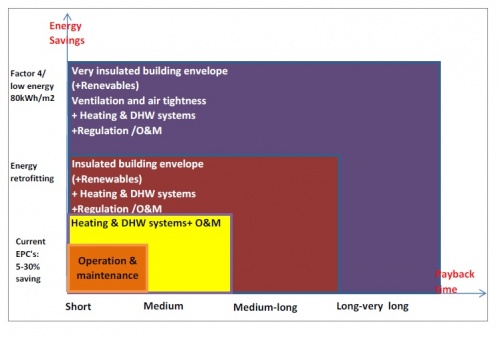Subsidy for long term investments and funding schemes
The key for successful implementation of energy strategies is well structured financial support, in national or regional level, or provided as bank loans, as well as other types of financing.
Contents
Banks and Financial instruments
Classic financial institutions funding - credit, overdraft, leasing, including international financial institutions like the ERDB and the World Bank credit accounts to banks. In (PassREg) data base banks and financial instruments are represented in FRR’s of Hannover and Brussels. There are few financial instruments to promote Passive House Standard for new building in Hannover region. Combined schemes of financial support are represented, like Subsidy programs for Passive houses, for example Kreditanstalt für Wiederaufbau (KfW), and Nbank. Kreditanstalt für Wiederaufbau, KfW, is a bank for funding energy efficient building, new construction and refurbishment. It subsidizes projects to reduce CO2 emissions and RES technologies. Either loans or grants are available. KFW accepts PHPP (Passive House Planning Package) as verification of energy efficient design. Key feature – bank accepts PHPPcalculation.
Nbank DE is state owned Funding bank providing zero-interest loans for energy-efficient retrofit.
Brussels presents variety of support instruments, including financial ones. CREDAL, a credit cooperative based in Brussels, provides the funds for loans, while Brussels Environment acts as an intermediary. Green loans are zero-interest social loans for retrofit in line with Passive House standard, specifically targeted to low-income families, for whom the burden of increased renovation costs is the heaviest. Two types of renovations qualify for green loans: insulation and effective heating improvements. Key feature – support for low income families.
Structural funds
Structural funds like European Regional Development Fund (ERDF), Cohesion Fund are sources of co-financing for the next financial period 2014-2020. These funds in other European countries, for example, Latvia, are still available in 2013.
State aid programs
State aid programs of CO2 emissions trading, as the assets of Green Investment Schemes or Climate Change Financial Instrument (CCFI), and the EU Emissions Trading Scheme (ETS) are instruments with good potential when developed in compliance with best practice examples. In future, it could help balance the emissions between industrial and household sector, develop local RES and micro-generation systems. In FRR’s State Aid is represented in Hannover region, where BAFA (Bundesamt fur Wirtshaft und Ausfuhrkontrolle) provides funding for renewable energy projects - Assistance is provided for solar units, photovoltaics in schools and biomass boilers. Under the programme "Local consultations to save energy" BAFA provides grants for consultations with home owners by qualified engineers aiming the reduction of heat consumption in buildings. BAFA collaborates with DEnA(German Energy Agency) by granting federal subsidies in saving energy for private households, companies and public administration, as well as for RES.
Export credit facilities
Export credits facilities (Exim Bank, TOPIC, etc.) is the state help for exporting technologies, to other countries. It is financial instrument for smart and complex technologies, works as a loan guarantee for the initial stage of spreading technologies, like RES, energy storage, heat recuperation, micro-generation and others. An Export credit agency (known in trade finance as ECA) or Investment Insurance Agency, is a private or quasi-governmental institution that acts as an intermediary between national governments and exporters to issue export financing. The financing can take the form of credits (financial support) or credit insurance and guarantees or both, depending on the mandate the ECA has been given by its government. ECAs can also offer credit or cover on their own account.
ESCO funds and Public Private Partnership
Economic and environmental protection aspects: ESCO assumes full risk / liability for - choice of energy efficiency measures, procurement of the necessary funding, selected energy efficiency measures, increase energy levels have been reached, energy monitoring during the contract period. ESCO undertakes a project financial, technical and commercial risks, works with your personal or funds raised, so no financial pressure on customers; Client assets are not pledged therefore the intake is a risk for ESCO financial stability (solvency) during the execution of contract. At the end of the agreement of Energy Efficiency, customer receives possession of all investments/ equipment, acquired for performance within the contract.
More information about Energy service companies (ESCOs)
EPC scope and profitability
A public–private partnership (PPP) is a government service or private business venture which is funded and operated through a partnership of government and one or more private sector companies. PPP involves a contract between a public sector authority and a private party, in which the private party provides a public service or project and assumes substantial financial, technical and operational risk in the project.
How does it works – EPC?
In FRR’s, PPP is represented in Hannover region. The proKlima - Enercity-Fonds operates on the basis of public-private partnership, in which the municipality and Stadtwerke Hannover AG play a key role together with 5 more neighbour municipalities. The proKlima Fund provides annually 5 MEUR, thus supporting the energy renovation of buildings, introduction of the Passive House Standard, as well as the introduction of energy efficient technologies and renewable energy. proKlima subsidy conditions include: the certification procedure for the Passive Houses construction method and energy efficiency quality assurance for insulation works, heating and ventilation.
Key feature – Passive House certification and quality control.
National and regional programs
National and regional programs are well presented by FRR’s: Brussels, Hanover and Tyrol, and show successful examples of combined financial instruments. Brussels. The €60 million in financial assistance that the Brussels-Capital Region puts aside each year is deducted from the total energy bill of all energy consumers in the year. The private energy providers receive about €1.5 billion per year, of which they are obliged to return approx. 0.04% of the total energy bill amount to the Brussels Government. This financing is the base for the financial help for environmental measures. Thus the Brussels region has a large portfolio of financial instruments for energy savings. The Exemplary Buildings program (Bâtiments Exemplaires, or BatEx) is the main financial incentive instrument, based on a yearly call for proposals. It encourages demand for very high energy and environment efficiency construction. Funds are available for housing, schools, hospitals, and offices; commercial and industrial facilities. All projects must comply with the Passive House standard, towards Zero-emission building, and use of eco-friendly construction materials. Moreover, the projects must have high architectural quality and be well integrated in the environment, with reasonable costs. Key feature – quality of architecture and environment.
Energy subsidies aim to cover part of the excess costs for high energy efficiency investments according to Passive House standards, for housing and businesses. Subsidized activities are energy audits, insulation, Passive House windows, ventilation, high-performance boilers and other. The subsidies goes for new Passive Houses (100 €/m²); for Low (100 €/m²), very low (130 €/m²) and Passive House renovation (160 €/m²). The subsidies are adjusted according to household income, with a special focus on low-income families. Key feature – distribution of subsidies regarding energy goal and family income.
Federal tax reduction for Passive construction represent different tax breaks for Low-energy, Passive House and Zero-energy building. The tax reductions are valid for a period of 10 years and updated annually, as far as the building follows Passive House construction guidelines.
Tyrol. The klima:aktiv national programme is part of the Austrian strategy for climate protection and consists of more than 20 sub-programmes. One of the objectives of the programme is attracting additional investments in energy efficiency and renewable energy. Another national programme is the Austrian programme on Technologies for Sustainable Development. It aims to promote effective restructuring of the economy towards sustainability. Residential Subsidies in Tyrol(Wohnbauförderungsrichtlinie) are provided for renovation of residential buildings, and developers are rewarded for quality renovations with an financial eco-bonus. „Promotion of Domestic Environmental Protection” and “Promotion of Energy Conservation Measures in Tyrol” are the programmes for the private service sector at national and provincial levels. Under these programmes energy efficiency measures and use of RES are supported.
Hanover. At the end of the 1990’es Hanover Municipality and Stadtwerke Hannover AG created the unique financial instruments proKlima. It became the main initiator and motor of the practical realization of Local Agenda 21 and the ensuing multitude of energy efficiency projects in the Hanover region. Construction of Passive buildings with the use of renewable energy sources often requires additional initial investments, which discourage some investors. For overcoming that barrier Hanover Municipality offers combined schemes of financial support, involving other institutions as well. These are, for instance, the KfW (Kreditanstalt fur Wiederaufbau), BAFA (Bundesamt fur Wirtschaft und Ausfuhrkontrolle) and the Hanover Region.
The "Hannover-Kinder-Bauland-Bonus” ("building for children’ bonus") is a special subsidy program provided by the Region Hannover for young families in Hannover with children under 16 years old. This bonus reduces the price of building land dramatically, with a 10% discount for each child up to a maximum of four. Also, HaKiBaBo is considered in banks as client's own capital.
Outside the FRR's there are fewer subsidies available.
In the UK, there are no subsidies towards the construction cost of high energy efficiency buildings. However, there are funding mechanisms in place to support the installation of renewable energy technologies.
The Feed in Tariff scheme (FIT) subsidises investment in relatively small scale (<5MW) electricity producing systems. The funding is generated via an obligation placed on Utility providers (essentially paid for via a cost levy on consumers). The payment received is broken into two separate parts; the Generation rate, which gives a payment for every kWh electricity produced by the system regardless of where it is used, plus the Feed in rate, which gives a payment for every kWh electricity exported back to the electricity grid. Applicable technologies and rates can be found on (the energy saving trust website). Such funding can obviously help to recover the costs of electricity producing systems that are incorporated into Passivhaus buildings in the UK.
The Renewable Heat Incentive (RHI) scheme was set up to subsidise investment in small scale renewable heating systems, such as biomass systems or solar hot water systems. The RHI is administered by the official regulator Ofgem who pay the tariffs with money from the Treasury. Applicable technologies and rates can be found on (the energy saving trust website).
In order to qualify for the FIT or RHI payments, both the installed product and the installation company must be certified under the Microgeneration Certification Scheme (MCS). See (the MCS website). The MCS is an internationally recognised quality assurance scheme for technologies used to produce electricity and heat from renewable sources. MCS also certifies installation companies to ensure the microgeneration products have been installed and commissioned to the highest standard for the consumer. The certification is based on a set of installer standards and product scheme requirements.
Examples
proKlima-"Enercity-Fonds" (DE)
Hannover-Kinder-Bauland-Bonus (DE)
Kreditanstalt für Wiederaufbau, KfW (DE)
BAFA (DE)
Energy subsidy in Brussels (BE)
Green Loans (BE)
Federal tax reduction for passive construction (BE)
Nbank (DE)
klima:aktiv - Austrian Climate Protection Programme (AT)
Austrian Programme on Technologies for Sustainable Development "Nachhaltig Wirtschaften" (AT)
Action Programme "Tyrol Economy": Energy Consulting (AT)
Residential Subsidies in Tyrol (Wohnbauförderungsrichtlinie) (AT)





